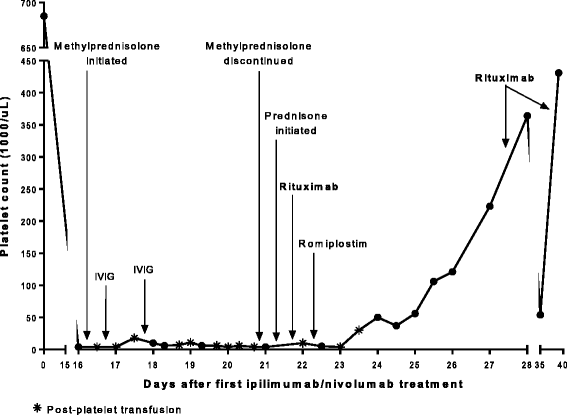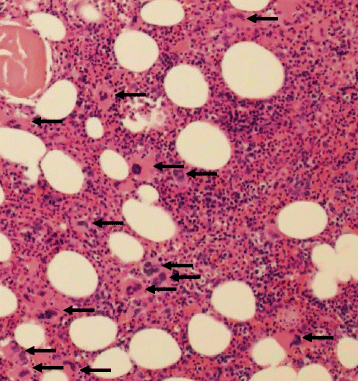Thrombocytopenia in patients with melanoma receiving immune checkpoint inhibitor therapy
- PMID: 28239462
- PMCID: PMC5319013
- DOI: 10.1186/s40425-017-0210-0
Thrombocytopenia in patients with melanoma receiving immune checkpoint inhibitor therapy
Abstract
Background: Immune checkpoint inhibitors, including antibodies against programmed death 1 (PD-1) and cytotoxic T-lymphocyte antigen 4 (CTLA-4), are being used with increasing frequency for the treatment of cancer. Immune-related adverse events (irAEs) including colitis, dermatitis, and pneumonitis are well described, but less frequent events are now emerging with larger numbers of patients treated. Herein we describe the incidence and spectrum of thrombocytopenia following immune checkpoint inhibitor therapy and two severe cases of idiopathic thrombocytopenic purpura (ITP).
Case presentations: A 47-year-old female with recurrent BRAF mutant positive melanoma received combination anti-PD-1 and anti-CTLA-4. Two weeks later, she presented with mucosal bleeding, petechiae, and thrombocytopenia and was treated with standard therapy for ITP with steroids and intravenous immunoglobulin (IVIG). Her diagnosis was confirmed with bone marrow biopsy, and given the lack of treatment response, she was treated with rituximab. She began to have recovery and stabilization of her platelet count that ultimately allowed her to be retreated with PD-1 inhibition with no further thrombocytopenia. A second patient, a 45-year-old female with a BRAF wild-type melanoma, received anti-PD-1 monotherapy and became thrombocytopenic 43 days later. Three weeks of steroid treatment improved her platelet count, but thrombocytopenia recurred and required additional steroids. She later received anti-CTLA-4 monotherapy and developed severe ITP with intracranial hemorrhage. Her ITP resolved after treatment of prednisone, IVIG, and rituximab and discontinuation of checkpoint inhibition. In a retrospective chart review of 2360 patients with melanoma treated with checkpoint inhibitor therapy, <1% experienced thrombocytopenia following immune checkpoint inhibition, and of these, most had spontaneous resolution and did not require treatment.
Conclusions: Thrombocytopenia, especially ITP, induced by immune checkpoint inhibitors appears to be an uncommon irAE that is manageable with observation in mild cases and/or standard ITP treatment algorithms. In our series, the majority of patients had mild thrombocytopenia that resolved spontaneously or responded to standard corticosteroid regimens. However, in two severe cases, IVIG and rituximab, in addition to steroids, were required. Checkpoint inhibition was resumed successfully in the first patient but rechallenge was not tolerated by the second patient.
Keywords: CTLA-4; Checkpoint inhibitor; Immune thrombocytopenic purpura; Melanoma; PD-1; Thrombocytopenia.
Figures


Similar articles
-
Recurrent Pneumonitis in Patients with Melanoma Treated with Immune Checkpoint Inhibitors.Oncologist. 2019 May;24(5):640-647. doi: 10.1634/theoncologist.2018-0352. Epub 2019 Feb 18. Oncologist. 2019. PMID: 30777894 Free PMC article.
-
Immunotherapy-associated autoimmune hemolytic anemia.J Immunother Cancer. 2017 Feb 21;5:15. doi: 10.1186/s40425-017-0214-9. eCollection 2017. J Immunother Cancer. 2017. PMID: 28239468 Free PMC article.
-
Metastatic uveal melanoma showing durable response to anti-CTLA-4 and anti-PD-1 combination therapy after experiencing progression on anti-PD-1 therapy alone.J Immunother Cancer. 2018 Feb 12;6(1):13. doi: 10.1186/s40425-018-0322-1. J Immunother Cancer. 2018. PMID: 29433557 Free PMC article.
-
Management of Adverse Events Following Treatment With Anti-Programmed Death-1 Agents.Oncologist. 2016 Oct;21(10):1230-1240. doi: 10.1634/theoncologist.2016-0055. Epub 2016 Jul 8. Oncologist. 2016. PMID: 27401894 Free PMC article. Review.
-
The Next Immune-Checkpoint Inhibitors: PD-1/PD-L1 Blockade in Melanoma.Clin Ther. 2015 Apr 1;37(4):764-82. doi: 10.1016/j.clinthera.2015.02.018. Epub 2015 Mar 29. Clin Ther. 2015. PMID: 25823918 Free PMC article. Review.
Cited by
-
Case Report: Thrombotic-Thrombocytopenic Purpura Following Ipilimumab and Nivolumab Combination Immunotherapy for Metastatic Melanoma.Front Immunol. 2022 Apr 20;13:871217. doi: 10.3389/fimmu.2022.871217. eCollection 2022. Front Immunol. 2022. PMID: 35514990 Free PMC article.
-
Hematological Side Effects of Immune Checkpoint Inhibitors: The Example of Immune-Related Thrombocytopenia.Front Pharmacol. 2019 Apr 26;10:454. doi: 10.3389/fphar.2019.00454. eCollection 2019. Front Pharmacol. 2019. PMID: 31105573 Free PMC article. Review.
-
Idiopathic thrombocytopenic purpura treatment in a relapsed/refractory multiple myeloma patient after chimeric antigen receptor T cell therapy.Regen Ther. 2020 May 15;14:271-274. doi: 10.1016/j.reth.2020.03.005. eCollection 2020 Jun. Regen Ther. 2020. PMID: 32455157 Free PMC article.
-
Management of Immune-Related Adverse Events in Patients Treated With Immune Checkpoint Inhibitor Therapy: American Society of Clinical Oncology Clinical Practice Guideline.J Clin Oncol. 2018 Jun 10;36(17):1714-1768. doi: 10.1200/JCO.2017.77.6385. Epub 2018 Feb 14. J Clin Oncol. 2018. PMID: 29442540 Free PMC article.
-
Clinical characteristics, treatment, and outcomes of nivolumab induced immune thrombocytopenia.Invest New Drugs. 2024 Oct;42(5):575-580. doi: 10.1007/s10637-024-01472-w. Epub 2024 Sep 12. Invest New Drugs. 2024. PMID: 39264523
References
Publication types
MeSH terms
Substances
Grants and funding
LinkOut - more resources
Full Text Sources
Other Literature Sources
Research Materials
